Motto "Open Sea, Safe Land" | Type Navy Founded 1948 | |
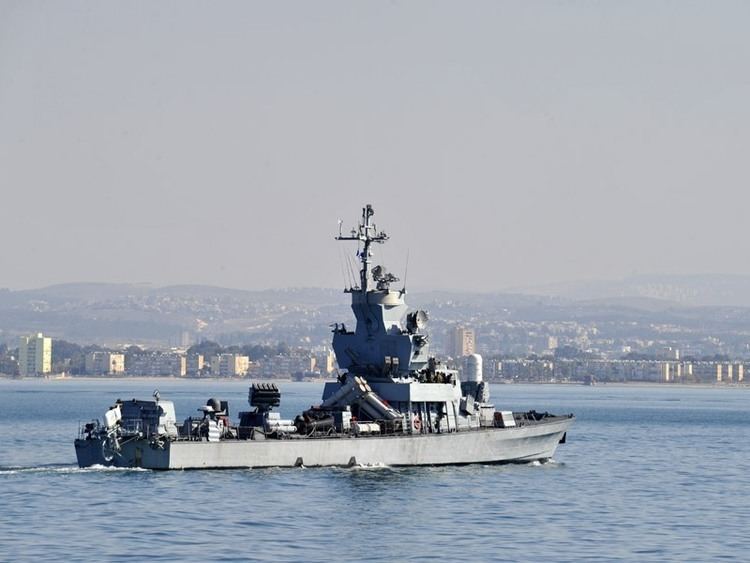 | ||
Size 3 corvettes (Sa'ar 5-class)8 missile boats (Sa'ar 4.5-class)5 submarines (Dolphin-class)45 patrol boats2 support ships9,500 Active10,000 Reserve Similar Israel Defense Forces, Shayetet 13, Israeli Air Force, Israeli Intelligence Corps, GOC Army Headquarters | ||
The Israeli Navy (Hebrew: חיל הים הישראלי, Ḥeil HaYam HaYisraeli (English: Sea Corps of Israel); Arabic: البحرية الإسرائيلية) is the naval warfare service arm of the Israel Defense Forces, operating primarily in the Mediterranean Sea theater as well as the Gulf of Aqaba and the Red Sea theater. The current commander in chief of the Israeli Navy is Aluf Eli Sharvit. The Israeli Navy is believed to be responsible for maintaining Israel's offshore nuclear second strike capability.
Contents
- History
- Yom Kippur War
- Chain of Command
- Bases
- Patrol Squadrons
- 3rd Flotilla
- 7th Flotilla
- 13th Flotilla
- YALTAM 707
- Intelligence
- Marines
- Fleet
- Saar 5 class
- Saar 45 class
- Dolphin class
- Commando boats
- Aircraft
- Unmanned aerial vehicles
- Equipment
- Future
- List of commanders
- References
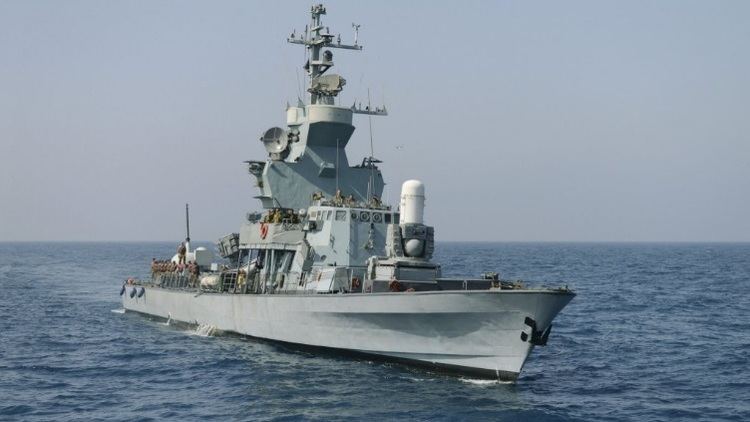
History
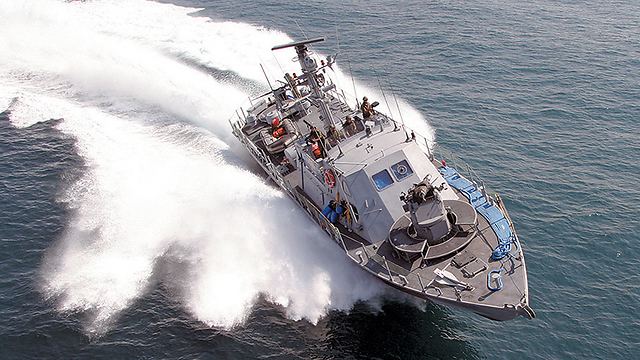
The origins of the Israeli Navy lay in the founding of the Betar Naval Academy, a Jewish naval training school established in Civitavecchia, Italy, in 1934 by the Revisionist Zionist movement under the direction of Ze'ev Jabotinsky, with the agreement of Benito Mussolini. The Academy trained cadets from all over Europe, Palestine and South Africa and produced some of the future commanders of the Israeli Navy. In September 1937, the training ship Sarah I visited Haifa and Tel Aviv as part of a Mediterranean tour.
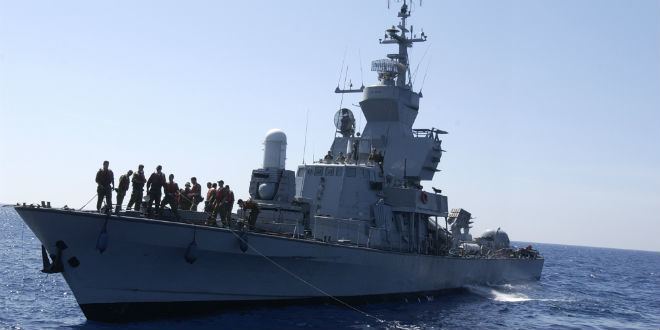
In 1938, encouraged by the Jewish Agency, Dr. Shlomo Bardin founded the Marine High School in Bosmat, the Technion's Junior Technical College. 1943 witnessed the founding of the Palyam, the naval branch of the Palmach, whose training was undertaken at the maritime school. The Jewish merchant marine was also raised, operating the SS Tel-Aviv and cargo ships such as the Atid.
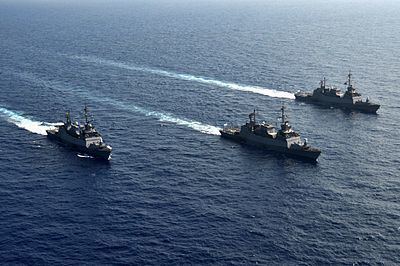
In 1942, eleven hundred Haganah volunteers joined the Royal Navy, mostly in technical roles (12 of them were officers by the nomination agreement of the Jewish Agency with the Royal Navy). A few reached sea service and combat service. Two of them served with the Fleet Air Arm (FAA), one of whom was Edmond Wilhelm Brillant and the other Zvi Avidror. With the end of the Second World War, Palyam members took part in clandestine immigration activities, bringing Europe's Jews to Palestine, as well as commando actions against Royal Navy deportation ships. Royal Navy volunteers, meanwhile, rejoined the Haganah.
During the last months of British Mandate in Palestine, the former Royal Navy volunteers started work on the captured clandestine immigration ships (known as the Fleet of Shadows) in Haifa harbor, salvaged a few and pressed them into service. These were to become the Navy's first ships and saw service in the 1948 Israeli War of Independence.
At the outset of the 1948 war and with the founding of the IDF, the Israeli Navy consisted of four former Aliyah Bet ships impounded in Haifa harbor. These ships were refurbished by a newly formed naval repair facility with the assistance of two private shipbuilding and repair companies. In October 1948, a submarine chaser was purchased from the United States. With the founding of the IDF in early 1948, the Israeli Navy was therefore formed from a core of the following personnel:
During the war, the warships served on coastal patrol duties and bombarded Arab targets on land, including Egyptian coastal installations in and around the Gaza area all the way to Port Said. The Israeli Navy also engaged the Egyptian Navy at sea during Operation Yoav, and the Egyptian Navy's flagship, the Emir Farouk, was sunk in an operation by Israeli naval commandos.
To make matters worse, Palyam personnel often resisted efforts to instil order, discipline and rank in the newly formed service. Mess rooms were initially shared by both officers and enlisted men. Ships possessed a captain with nautical skills, but also a commanding officer regarded as political. This would cause a great deal of debate between veterans of the Palyam, Royal Navy volunteers from the Haganah and U.S. Navy Machal volunteers about what form the Navy should take. Commander Allen Burk is reputed to have said, out of despair, "You cannot make naval officers from cowboys".
RN Captain Ashe Lincoln, who was Jewish, advised PM Ben-Gurion to purchase corvettes, frigates, destroyers, torpedo-boats, and patrol boats to build up the Israeli Navy power. For that sake he urged Ben-Gurion to consult with professional navy advisers. This resulted in instructions to contact U.S. Navy advisors, mainly Commander Paul Shulman from the U.S. Navy.
The Israeli Navy suffered from a lack of professional command during its early days. Gershon Zak, head of the IDF "Sea Service", was a teacher and bureaucrat without any relevant experience. Having never been recruited into the IDF, Zak was a civilian and had no official rank. The early days of the Israeli Navy were therefore characterized by political infighting, as many groups and individuals jockeyed for power. Palyam politics blocked the nomination of Paul Shulman (a Jewish U.S. Navy officer with a rank of Commander who volunteered for the Israeli Navy) as Navy-Commander in Chief and he resigned in 1949. The first Navy-Commander in Chief awarded the rank of Aluf was Shlomo Shamir.
The conclusion of the 1948 war afforded the navy the time to build up its strength. Beginning in the early 1950s the navy purchased frigates, torpedo boats, destroyers, and eventually submarines. The material build-up was accompanied by the training of Israeli Navy officers in Royal Navy academies in the UK and Malta, as well as in France.
Three distinct periods characterize the history of the Israeli Navy:
Until 1967 the Naval Headquarters were located at Stella-Marris, on the slopes of Mount Carmel, Haifa. After the Six-Day War it was relocated to the Kirya in Tel Aviv, next to IDF Headquarters.
Yom Kippur War
In the most significant engagement in its history, during the Yom Kippur War the Israeli Navy sank five Syrian ships without a loss during the Battle of Latakia. As a result, the Syrian Navy remained in port for the remainder of the conflict.
Chain of Command
The Israeli Navy is small compared to other Navies and the officers chain of command is as follows with respect to Royal – Navy / United States:
Sleeve rank of Israeli Navy Commander-in-Chief is a rank of honor. This began as special permission from Lt. General Amnon Lipkin-Shahak (then chief of staff of the IDF) and allows the Navy Commander-in-Chief to have a sleeve rank of Vice Admiral which is equal to Lt. General, the rank of the IDF Chief of Staff. However the de facto rank of Israeli Navy Commander-in-Chief is Rear Admiral and the gesture given to the navy is ceremonial only when meeting foreign commanding officers.
The same resolution as mentioned above applies to the rank of Commodore. There is ceremonial-only sleeve rank of Rear–Admiral while by the IDF hierarchy and chain of command he remains a commodore.
Bases
Patrol Squadrons
Based in Haifa, Eilat, and Ashdod respectively, Squadrons 914, 915, and 916 defend Israels' shores from near by.
Unit's objectives
3rd Flotilla
The Missile Boats Flotilla, based at Haifa.
7th Flotilla
The Submarine Flotilla, an elite volunteer unit founded in 1959.
For security reasons applicants with dual citizenship, must now officially renounce all other citizenships to be accepted into the submarine service training program.
13th Flotilla
Shayetet 13, or Flotilla 13, is an elite naval commando unit which specializes in sea-to-land incursions, counter-terrorism, sabotage operations, maritime intelligence gathering, maritime hostage rescue, and boarding. It is among the most highly trained and secretive units in the Israeli military.
YALTAM 707
Salvage and underwater works unit. Formed as the damage control branch of the Navy Shipyards, the unit later incorporated experienced Flotilla-13 divers.
Intelligence
The Corps' relies on its Naval Intelligence Division for naval intelligence.
Marines
The Givati Brigade, an infantry brigade of the Israel Defense Forces, served as its amphibious force until the early 1990s.
The 11th Flotilla (disbanded in 1993) would transport the troops on various transport vessels.
Fleet
"INS" stands for "Israeli Navy Ship".
Sa'ar 5-class
Sa'ar 4.5-class
Dolphin class
AIP Dolphin 2 class:
Commando boats
Aircraft
Aircraft operated by the Israeli Navy, even when including on-board Navy mission specialists, are flown and maintained by Israeli Air Force personnel and are part of the air force command structure.
Unmanned aerial vehicles
Equipment
Future
Three new Sa'ar 72-class corvettes are under construction at Israel Shipyards, the first of which should enter service in 2015. These are a stretched version of the Sa'ar 4.5 design that will incorporate stealth technology.
Despite some misgivings from Germany, the contract for the sixth and final Dolphin-class submarine is still intact and it should be operational by 2017. ThyssenKrupp will also build four "Sa'ar" patrol vessels for EEZ duties such as protecting offshore gas fields. The ships will be based on the MEKO A-100 design like Germany's Braunschweig-class corvettes, suggesting they will be 90m long and displace around 1,800 tonnes, named Sa'ar 6-class corvette. This deal was signed in December 2014 and Germany is believed to be contributing up to €115m of the €1 billion cost. Previously Israel had hoped to acquire an up-armed version of the Freedom class of littoral combat ships from Lockheed Martin, but spiralling costs had made this impossible, along with a fallback option from Northrop Grumman/Huntington Ingalls Industries who built the Sa'ar 5 class.
List of commanders
Source: Jewish Virtual Library
